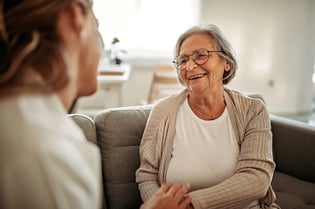 If you know someone who is recovering from a stroke or other acquired brain injury, you may have experienced a heightened level of difficulty when participating in conversations. Aphasia, or language difficulties as a result of a stroke, can impact a person’s ability to express themselves or understand information. This breakdown in communication can lead to feelings of isolation and distress.
If you know someone who is recovering from a stroke or other acquired brain injury, you may have experienced a heightened level of difficulty when participating in conversations. Aphasia, or language difficulties as a result of a stroke, can impact a person’s ability to express themselves or understand information. This breakdown in communication can lead to feelings of isolation and distress.
Group discussions - such as during the holiday season when friends and family gather more often - make the situation more difficult. Family and friends can provide support to the person with aphasia by utilizing strategies from the Supported Conversation for Adults with Aphasia (SCA™) approach. This communication method provides a communication partner with techniques to help facilitate conversation when interacting with someone with aphasia.
There are two main goals of Supported Conversation for Adults with Aphasia (SCA™):
- Help the person with aphasia show they understand spoken information, or get the message “in”
- Acknowledge what the person with aphasia is saying, or getting the message “out”
Getting the Message In
As the communication partner, you will help the person with aphasia confirm your message to them has been understood. There are a few things you can do to help increase comprehension, or get the message “in”.
- Speaking in simple sentences
- Using a multi-modal approach
- Using gestures
- Writing down keywords
- Creating or drawing illustrations focusing on single words
- Communicating in a distraction-free environment
Getting the Message Out
Another component of SCA™ is for you to help the person with aphasia to express their thoughts, or get the message “out”.
- Ask yes or no questions to confirm you understand their message
- For example: “Are you talking about work? Are you telling them about your recent doctor’s appointment?”
- Provide fixed choices
- For example: “Do you want pizza or hamburgers for dinner? Or Did you want to talk to Aunt Carol first or Uncle Steve?
- Encourage the person with aphasia to use different modalities to express themselves successfully
- Pointing
- Drawing pictures
- Writing keywords
- Using a communication board or device
- Increase your wait time so they have an opportunity to independently respond, even if that is a minute or two
An important part of getting the message “out” is to verify that you understood the person with aphasia and that their message is correct! This process is to ensure the person with aphasia feels like a valued communicator. You can do this by repeating their message but also expanding on what they said, adding gestures, writing keywords, and recapping conversation.
By using a natural tone of voice, selecting adult topics, and integrating the above techniques naturally, the communication partner is helping to show others that the person with aphasia is a competent communicator and capable of participating in complex conversations.
It is important to use these techniques when breakdowns occur during natural conversation. Choose a simple conversation to start with, and continue to build on these skills and the person with aphasia’s comfort level. We want people with aphasia to know they are valued and their thoughts are important and relevant.
Information courtesy of the Aphasia Institute https://www.aphasia.ca/communication-tools-communicative-access-sca/
For more information on stroke recovery and support, visit Northeast Ohio Adults Communicating Together (NEO-ACT).









